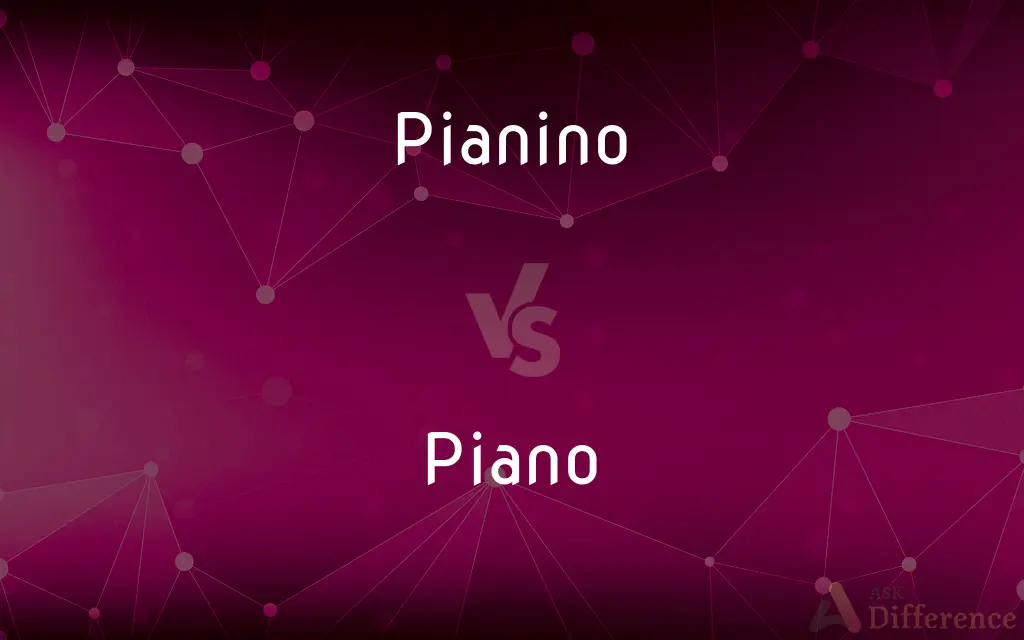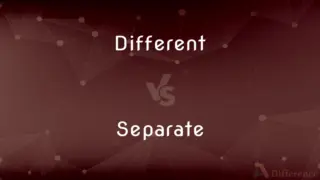Pianino vs. Piano — What's the Difference?
By Fiza Rafique & Maham Liaqat — Updated on March 27, 2024
A pianino is a type of upright piano designed for small spaces, emphasizing vertical structure, while a piano broadly includes grand and upright designs, offering diverse sound qualities.

Difference Between Pianino and Piano
Table of Contents
ADVERTISEMENT
Key Differences
A pianino is characterized by its compact size and vertical design, making it suitable for smaller rooms and spaces. Its construction aims to fit into limited areas without compromising the musical experience too much. On the other hand, pianos encompass a wider variety of types, including both grand and upright pianos, each designed for specific spatial and acoustic needs.
The sound quality of a pianino is generally considered to be less rich and resonant compared to larger pianos. This is due to its shorter strings and smaller soundboard. Whereas, grand pianos, in particular, are celebrated for their superior sound quality, which is a result of longer strings and a larger soundboard, allowing for more vibrant and fuller tones.
Pianinos often have a more affordable price point, making them accessible to beginners or those with budget constraints. This affordability comes from their smaller size and the materials used. On the other hand, grand and larger upright pianos are typically more expensive, reflecting their superior sound quality, craftsmanship, and material costs.
In terms of maintenance, pianinos might require less space and slightly less upkeep due to their compact nature. However, like all pianos, they need regular tuning and care to maintain their sound quality. In contrast, grand pianos, with their larger components and more complex mechanisms, might demand more frequent and specialized maintenance.
The choice between a pianino and a piano often depends on the user's space, budget, and sound quality preferences. Pianinos offer a practical solution for those with limited space and budget, while pianos, including grand and traditional upright models, provide a richer sound experience for those willing to invest more in their musical journey.
ADVERTISEMENT
Comparison Chart
Design
Compact and vertical
Includes grand and upright, varying in size
Sound Quality
Less rich, due to shorter strings
Richer and more vibrant, especially in grand pianos
Price
Generally more affordable
Ranges from moderately expensive to very high
Maintenance
Requires regular tuning, potentially less upkeep
Demands regular tuning and specialized maintenance
Suitable For
Small spaces and budgets
A range of spaces and users seeking quality sound
Compare with Definitions
Pianino
A small, compact upright piano designed for limited spaces.
The cozy apartment featured a pianino in the corner, blending seamlessly with the modest living space.
Piano
Offers a richer sound experience, favored by professionals.
The recording studio was equipped with a high-end piano to capture the best sound quality.
Pianino
Known for its vertical structure, optimizing floor space usage.
The pianino’s vertical design allowed for more walking space in the room.
Piano
Requires space and investment, especially for grand models.
Their new home included a dedicated space for the family’s cherished grand piano.
Pianino
May have a slightly compromised sound due to size.
While the pianino fit well in her space, Julia noticed it couldn't match the resonance of a grand piano.
Piano
Symbolizes a significant investment in musical artistry.
Acquiring a grand piano was a dream come true for Maria, marking a milestone in her musical career.
Pianino
A practical solution for combining musical passion with space limitations.
Opting for a pianino, Liam found a balance between his love for music and living in a small apartment.
Piano
Renowned for its dynamic range and expressive sound.
The concert pianist demonstrated the piano’s vast expressive capabilities with his performance.
Pianino
An instrument often chosen by beginners or those with budget constraints.
Emma chose a pianino for her first instrument, finding it a perfect fit for her small studio apartment.
Piano
A musical instrument with keys, strings, and a soundboard, available in grand and upright forms.
The grand piano, with its majestic form, stood as the centerpiece of the concert hall.
Pianino
(music) A pianette, or small piano.
Piano
The piano is an acoustic, stringed musical instrument invented in Italy by Bartolomeo Cristofori around the year 1700 (the exact year is uncertain), in which the strings are struck by wooden hammers that are coated with a softer material (modern hammers are covered with dense wool felt; some early pianos used leather). It is played using a keyboard, which is a row of keys (small levers) that the performer presses down or strikes with the fingers and thumbs of both hands to cause the hammers to strike the strings.
Pianino
A pianette, or small piano.
Piano
A large keyboard musical instrument with a wooden case enclosing a soundboard and metal strings, which are struck by hammers when the keys are depressed. The strings' vibration is stopped by dampers when the keys are released and can be regulated for length and volume by two or three pedals.
Piano
A passage performed or marked to be performed softly.
Piano
(especially as a direction) soft or softly.
Piano
(especially as a direction) soft or softly.
Piano
A musical instrument with a manual keyboard actuating hammers that strike wire strings, producing sounds that may be softened or sustained by means of pedals.
Piano
A passage to be played softly or quietly.
Piano
In a soft or quiet tone. Used chiefly as a direction.
Piano
(musical instruments) a percussive keyboard musical instrument, usually ranging over seven octaves, with white and black colored keys, played by pressing these keys, causing hammers to strike strings
The piano in his house takes up a lot of space.
She has been taking lessons for many years and now plays piano very well.
Piano
To play the piano.
Piano
(of or with fingers) To move (the fingers) up and down on, similar to the motions of a pianist playing the piano.
Piano
To equip with a piano.
Piano
To become softer and less intense.
Piano
(music) softly, as a musical direction (abbreviated to p. in sheet music)
Piano
(music) Soft, quiet.
Piano
(in extended use) Gentle, soft, subdued.
Piano
Soft; - a direction to the performer to execute a certain passage softly, and with diminished volume of tone. (Abbrev. p.
Piano
A well-known musical instrument somewhat resembling the harpsichord, and consisting of a series of wires of graduated length, thickness, and tension, struck by hammers moved by keys.
Piano
A stringed instrument that is played by depressing keys that cause hammers to strike tuned strings and produce sounds
Piano
(music) low loudness
Piano
Used chiefly as a direction or description in music;
The piano passages in the composition
Piano
Used as a direction in music; to be played relatively softly
Common Curiosities
Can a pianino produce the same sound quality as a grand piano?
Due to its smaller size and shorter strings, a pianino generally cannot match the rich and resonant sound quality of a grand piano.
How does a piano differ from a pianino?
A piano includes both grand and upright models, generally offering superior sound quality and larger dimensions compared to the more compact and affordable pianino.
Can a pianino fit in a small apartment?
Yes, pianinos are designed to fit in small spaces, making them ideal for apartment dwellers.
How does the choice of piano affect a musician's performance?
The choice of piano can significantly impact a musician's performance, with grand pianos offering a wider dynamic range and expressive possibilities compared to pianinos.
Is regular maintenance important for both pianinos and pianos?
Yes, regular tuning and care are crucial for maintaining the sound quality and functionality of both pianinos and pianos.
Are pianinos suitable for professional performances?
While pianinos can be used for practice and small venues, professionals often prefer grand or high-end upright pianos for performances due to their superior sound.
How do the costs of maintaining a pianino and a piano compare?
While both require regular maintenance, the cost may be slightly lower for pianinos due to their simpler mechanism and smaller size.
Why are grand pianos more expensive than pianinos?
Grand pianos are more expensive due to their larger size, superior sound quality, craftsmanship, and the higher quality materials used in their construction.
What is a pianino?
A pianino is a small, upright piano designed to fit in limited spaces, offering a compact option for those with space or budget constraints.
Who might choose a pianino over a piano?
Beginners, those with limited living space, or individuals on a budget might prefer a pianino for its affordability and space efficiency.
Is it easier to learn to play on a pianino or a piano?
Learning basics can be equally effective on both, but pianos, especially grand pianos, may offer a more comprehensive learning experience due to their sound quality and touch response.
How important is the soundboard size in a piano?
The size of the soundboard is crucial in determining the volume and quality of the piano’s sound, with larger soundboards found in grand pianos producing richer tones.
Can pianinos be used in music schools?
Yes, pianinos are often used in music schools for beginners and for practice rooms where space is limited.
Do pianinos come in different styles?
Like all pianos, pianinos can vary in style and design, though their primary feature is their compact, vertical structure.
How does the action of a pianino compare to that of a grand piano?
The action of a grand piano is generally more responsive and allows for greater dynamic control compared to a pianino, which may have a slightly different mechanism due to its compact size.
Share Your Discovery

Previous Comparison
Different vs. Separate
Next Comparison
East vs. WestAuthor Spotlight
Written by
Fiza RafiqueFiza Rafique is a skilled content writer at AskDifference.com, where she meticulously refines and enhances written pieces. Drawing from her vast editorial expertise, Fiza ensures clarity, accuracy, and precision in every article. Passionate about language, she continually seeks to elevate the quality of content for readers worldwide.
Co-written by
Maham Liaqat















































